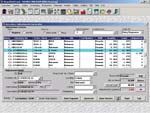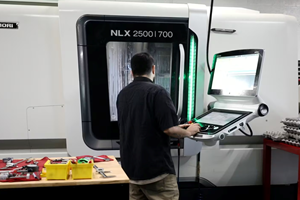Software Brings Better Control of Manufacturing Data
Like many businesses, this fitting manufacturer eagerly embraced new computer technology as it became available. But by the mid-1990s, its eight computers ran on three separate networks, based on operating system compatibility.
Like many businesses, fitting manufacturer Tylok International, Inc. (Euclid, Ohio), eagerly embraced new computer technology as it became available. But by the mid-1990s, its eight computers ran on three separate networks, based on operating system compatibility. "One of the frustrations before," says Mike Palinkas, systems manager at Tylok, "was if someone wanted to know something, you had to go to a specific computer to look it up."
Upon his arrival at Tylok, Mr. Palinkas began working to take control of manufacturing data. Four years and one fire later, Tylok had a new computer network consisting of 17 PCs.
Once the company replaced the patchwork of computer hardware, the next step was to eliminate errors and redundant data entry efforts. The big challenge was taking control of Tylok's complex, expanding inventory.
Part inventory numbers were problematic for Tylok. Mr. Palinkas recalls that the inability to distinguish finished stock from incomplete assemblies occasionally caused inside sales reps to promise customers unrealistic delivery dates. With approximately 4,000 standard part numbers, however, organizing Tylok's inventory was no small task.
Mr. Palinkas met this difficult inventory challenge by integrating the company's administrative functions under one shop management software package, Visual EstiTrack from Henning Industrial Software (Hudson, Ohio).
Mr. Palinkas developed a system in EstiTrack with three inventory classifications for each part number: assembled inventory, unassembled inventory and work in process.
That step was even more necessary because of the company's new line of interchangeable fittings. Mr. Palinkas has devoted a lot of time to adding new parts to inventory and developing a monthly report to compare sales of the old fittings to the new, as well as the total value of each that is in stock. "We are trying to get it on the shelf and into inventory, but there are about 700 standard sizes," he says. "That's a lot of parts, even if we only run a shop order for 3,000 each."
Initially, Tylok only produced the new line in stainless, but the company will eventually make it from 12 different materials including brass, steel, Inconel, Hastalloys, Monel, Polypropylene, Teflon and others. "Adding them to our inventory was easy because we already had the blueprint laid out when we installed EstiTrack," Mr. Palinkas explains.
The inventory blueprint consists of two appendices Mr. Palinkas and Billie Henning of Henning Industrial Software added to Tylok's Visual EstiTrack training manual. The first details the process the company uses for selecting its distributor codes, and the second explains how inventory numbers are derived for new parts or new sizes of existing parts.
As with any good inventory system, EstiTrack includes a minimum-quantity safety level in the finished goods inventory. If the inventory drops below the minimum, it appears on a reorder report. Ms. Henning helped design a report for Tylok that shows both the number of finished pieces and those awaiting assembly to determine what was needed to regain the inventory minimum, and whether those pieces had to merely be assembled, or if they had to be machined as well. The report "saves us about 35 pages in our reports and shows what we really need," Mr. Palinkas says.
"When we do a search on a part number for 10,000 pieces that need to ship, all three inventory classifications come up for each part number—assembled inventory, unassembled inventory and work in process—and sales knows exactly what is going on. If the finished goods inventory shows 0 and there are 10,000 pieces that need to be assembled, then they know they can't promise overnight delivery," he explains.
By controlling the pace of implementation, Mr. Palinkas has been able to maintain control of Tylok's operations and to improve them, as functions previously unavailable are added to the system. Two such functions are tracking quotes and tracking true part costs. With labor and material costs captured, the shop can define discounts for distributors without losing money.
"Under the old system," Mr. Palinkas recalls, "when distributors buying in volume requested larger than normal discounts, there were sometimes questions about whether or not Tylok could meet the request and remain profitable." He recalls that he had no quick way of using the available information to determine whether or not the shop would make or lose money on the sale. "That is really what I am getting in this software," he says. "It is totally integrated, it has everything in it and I know that when someone asks how much it costs to make the part, I can answer the question."
Thanks to its new computer network and integrated shop management system, Tylok not only has better access to its information, but it also has access to a successful future.
Related Content
ERP Provides Smooth Pathway to Data Security
With the CMMC data security standards looming, machine shops serving the defense industry can turn to ERP to keep business moving.
Read MoreHow this Job Shop Grew Capacity Without Expanding Footprint
This shop relies on digital solutions to grow their manufacturing business. With this approach, W.A. Pfeiffer has achieved seamless end-to-end connectivity, shorter lead times and increased throughput.
Read MoreWhen Handing Down the Family Machine Shop is as Complex as a Swiss-Turned Part
The transition into Swiss-type machining at Deking Screw Products required more than just a shift in production operations. It required a new mindset and a new way of running the family-owned business. Hardest of all, it required that one generation let go, and allow a new one to step in.
Read MoreERP Captures Process Know-How Before it Retires
As shops struggle to overcome the skills gap, ERP systems can improve the onboarding process and help document processes as skilled workers retire.
Read MoreRead Next
The Cut Scene: The Finer Details of Large-Format Machining
Small details and features can have an outsized impact on large parts, such as Barbco’s collapsible utility drill head.
Read MoreObscure CNC Features That Can Help (or Hurt) You
You cannot begin to take advantage of an available feature if you do not know it exists. Conversely, you will not know how to avoid CNC features that may be detrimental to your process.
Read More3 Mistakes That Cause CNC Programs to Fail
Despite enhancements to manufacturing technology, there are still issues today that can cause programs to fail. These failures can cause lost time, scrapped parts, damaged machines and even injured operators.
Read More

















.png;maxWidth=300;quality=90)









